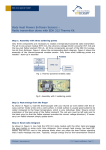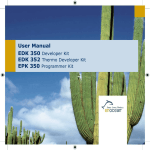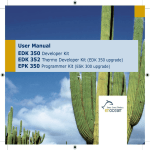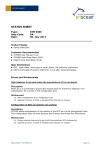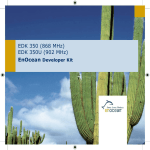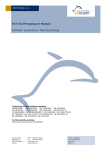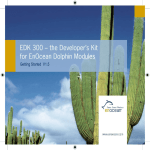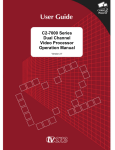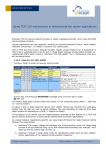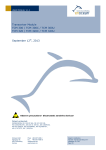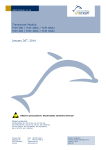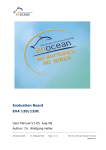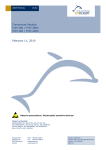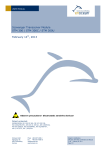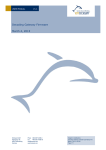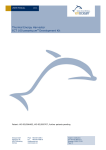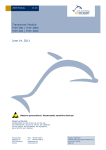Download EDK 300 User Manual V1.4
Transcript
USER MANUAL V1.4 EDK 300 / EDK 300C Developer’s Kit for EnOcean Dolphin Modules Covered by at least following patents: W098/36395 | DE 10025561 | DE 10062028 | DE 10150128 DE 10155125 | DE 10063305 | DE 10301678 | DE29712270.3 W O00/043802 | DE 202004005837.5 | EP 1389358 | US 7,005,778fnding: http://www.enocean.com/en/patents/ © EnOcean GmbH Kolpingring 18a 82041 Oberhaching Germany Phone +49.89.67 34 689-0 Fax +49.89.67 34 689-50 [email protected] www.enocean.com Subject to modification EDK 300(C) User Manual Dec. 2010 Page 1 / 46 USER MANUAL V1.4 EDK 300 / EDK 300C DEVELOPER’S KIT FOR ENOCEAN DOLPHIN MODULES REVISION HISTORY The following major modifications and improvements have been made to the first version of this document: No 1.0 1.1 1.2 1.3 1.4 Major Changes Initial version Changed size of ext. energy storage modul Updated to new DolphinStudio and WinEtel DolphinView added / WinEtel removed Published by EnOcean GmbH, Kolpingring 18a, 82041 Oberhaching, Germany www.enocean.com, [email protected], phone +49 (89) 6734 6890 © EnOcean GmbH, All Rights Reserved Important notes This information describes the type of component and shall not be considered as assured characteristics. No responsibility is assumed for possible omissions or inaccuracies. Circuitry and specifications are subject to change without notice. For the latest product specifications, refer to the EnOcean website: http://www.enocean.com. As far as patents or other rights of third parties are concerned, liability is only assumed for modules, not for the described applications, processes and circuits. EnOcean does not assume responsibility for use of modules described and limits its liability to the replacement of modules determined to be defective due to workmanship. Devices or systems containing RF components must meet the essential requirements of the local legal authorities. The modules must not be used in any relation with equipment that supports, directly or indirectly, human health or life or with applications that can result in danger for peo-ple, animals or real value. Components of the modules are considered and should be disposed of as hazardous waste. Local government regulations are to be observed. Packing: Please use the recycling operators known to you. This evaluation kit and its components are intended for use for evaluation, demonstration or engineering development purposes only. It is not considered to be a finished end product fit for consumer use. Persons handling this developer kit must have electronics expertise and observe good engineering practice standards. As such, the goods being provided are not intended to be complete in terms of required design, marketing, and/or manufacturing related protective considerations, including product safety and environmental measures typically found in end products that incorporate such electronic components or circuit board. EnOcean will not be reliable for consequences of any HW or SW changes/modifications of the developer board(s) done by the developer. Before using EDK 300 please consider country specific radio regulations and frequencies, e.g. R&TTE (EDK 300 = 868 MHz) for the European Union or FCC (EDK 300C = 315 MHz) for US. © 2010 EnOcean | www.enocean.com Dec. 2010 | Page 2 / 46 USER MANUAL V1.4 EDK 300 / EDK 300C DEVELOPER’S KIT FOR ENOCEAN DOLPHIN MODULES For users in Japan: This developer kit is not certified as confirming to technical regulations of radio law of Japan. If you use this kit in Japan, you are required by Radio Law of Japan to follow the instruc-tions below with respect to this product: Use this product in a shielded room or any other test facility as defined in the notification #173 issued by Ministry of Internal Affairs and Communications on March 28, 2006, based on sub-section 1.1 of article 6 of the “Rule for Enforcement of Radio Law of Japan”. Use this kit only after you obtained the license of “Test Radio Station” as provided in Radio Law of Japan with respect to this product, or use of this product only after you obtained the technical regulations conformity certification as provided in radio law of Japan with respect to this product. Do not transfer this product, unless you give the same notice above to the transferee. Please note that if you could not follow the instructions above, you will be subject to penalties of Radio Law of Japan. Observe precautions! Electrostatic sensitive devices! © 2010 EnOcean | www.enocean.com Dec. 2010 | Page 3 / 46 USER MANUAL V1.4 EDK 300 / EDK 300C DEVELOPER’S KIT FOR ENOCEAN DOLPHIN MODULES TABLE OF CONTENT 1 2 3 4 5 General Description ............................................................................................ 5 1.1 Basic Functionality....................................................................................... 5 1.2 Transceiver modules .................................................................................... 7 1.3 Sensor modules .......................................................................................... 7 1.4 Self-powered push button............................................................................. 8 Content and ordering information ......................................................................... 9 PC Software......................................................................................................10 3.1 Overview & Installation ...............................................................................10 3.2 DolphinStudio ............................................................................................10 3.3 DolphinView ..............................................................................................12 3.4 DolphinAPI (Documentation) ........................................................................15 3.5 Firmware Development Process ....................................................................17 3.6 Development Process and Keil μVision (PK51) EnOcean ...................................18 EOP 300 programmer ........................................................................................19 7 EVA 300 evaluation board for TCM 3x0 .................................................................20 5.1 Overview...................................................................................................20 5.1.1 Voltage jumpers .....................................................................................21 5.1.2 Buttons .................................................................................................21 5.1.3 LED indicators ........................................................................................22 5.1.4 TCM 3x0 modes of standard firmware........................................................23 5.1.5 EnOcean address ID learn procedure (teach-in) ..........................................24 5.2 TCM 3x0 mode 1: bidirectional serial communication .......................................25 5.3 TCM 3x0 mode 2: 1-channel relay switch .......................................................26 5.4 TCM 3x0 mode 3: 4-channel relay switch .......................................................27 Learn procedure: .............................................................................................27 5.5 TCM 3x0 mode 4: 1-channel dimmer.............................................................28 5.6 TCM 3x0 repeater.......................................................................................29 EVA 320 evaluation board for STM 300 .................................................................30 6.1 Overview...................................................................................................30 6.2 Power management and energy storage ........................................................32 6.3 Pin and data byte assignment of sensor inputs ...............................................33 6.4 STM 300 firmware configuration with DolphinStudio ........................................35 6.5 Self-Powered temperature sensor demonstration ............................................36 6.6 Self-powered room operating panel demonstration..........................................37 6.7 Solar-Powered ambient light sensor ..............................................................38 6.8 Self-Powered temperature sensor with long term storage status........................39 6.9 Extensions.................................................................................................41 6.9.1 External energy harvester........................................................................41 6.9.2 External solar cell ...................................................................................41 6.9.3 ECT 310 Perpetuum Module .....................................................................41 Further documents ............................................................................................42 8 Abbreviations....................................................................................................43 9 Annex..............................................................................................................44 9.1 EVA 300 jumpers, buttons and LEDs .............................................................44 9.2 EVA 320 jumpers, buttons and LEDs .............................................................45 9.3 Radio Telegrams according to EnOcean Alliance Standardization........................46 6 © 2010 EnOcean | www.enocean.com Dec. 2010 | Page 4 / 46 USER MANUAL V1.4 EDK 300 / EDK 300C DEVELOPER’S KIT FOR ENOCEAN DOLPHIN MODULES 1 General Description 1.1 Basic Functionality Thank you for purchasing this developer kit, and welcome to the innovative world of self-powered applications. Before you start developing self-powered solutions it is essential to understand the specific needs of this technology: Self-powered devices use micro energy harvesters, en- ergy is always a resource that requires extraordinary design attention Energy efficiency during radio reception and transmis- sion is of key importance Transmission duration directly affects communication robustness Data processing capabilities of EnOcean chip and modules are closely linked with the user application and energy budget of a customer specific usage EDK 300 (868 MHz) and EDK 300C (315 MHz) are comprehensive developer kits to implement innovative applications for the fast growing market of self-powered sensor/actuator solutions with radio communication. Following image illustrates the basic concept: © 2010 EnOcean | www.enocean.com Dec. 2010 | Page 5 / 46 USER MANUAL V1.4 EDK 300 / EDK 300C DEVELOPER’S KIT FOR ENOCEAN DOLPHIN MODULES Self-powered, wireless sensor: The wireless sensor module harvests energy from its environment. This can for example be done by push button, solar or thermo energy converters. More details about micro harvesting technologies can be found at: http://www.enocean.com/en/energy-harvesting/ Valuable electrical energy has to be carefully stored and managed in order to power sensor circuit, microcontroller and radio interface. Most of the time a self-powered wireless sensor is in sleep mode to save energy, if the sensor value (e.g. temperature) changes it will wake up and send this value via radio telegram. Periodical wake and send cycles (e.g. 15 min) are providing keep alive telegrams with actual sensor values. EnOcean has optimized the modules of the product family STM 3xy (868 MHz) and STM 3xyC (315 MHz) for such kind of applications. Line powered transceivers: In most applications, line powered transceivers work as a counterpart to self-powered, wireless sensors. The receive telegrams, interpret them and perform actions. Line powered transceivers can for example be implemented as gateway to other communications systems, as repeater or as actuator to switch on/off lights. TCM 3x0 (868 MHz) and TCM 3x0C (315 MHz) supporting line powered applications especially for building automation. © 2010 EnOcean | www.enocean.com Dec. 2010 | Page 6 / 46 USER MANUAL V1.4 EDK 300 / EDK 300C DEVELOPER’S KIT FOR ENOCEAN DOLPHIN MODULES 1.2 Transceiver modules The TCM 3x0 module provides several built-in operating modes. In addition repeater functionality (1 or 2 level) can be activated. Using the Dolphin API library it is possible to write custom software for the module. Built-in operating modes (Standard firmware) Unidirectional serial communication Bidirectional serial communication 1-channel relay mode 4-channel relay mode 1-channel dimming mode Features accessible via API Integrated 16 MHz 8051 CPU with 32 kB FLASH and 2 kB SRAM Up to 14 configurable I/Os 10 bit ADC, 8bit DAC TCM 320 TCM 300 For a detailed technical description see TCM 3x0 user manual. 1.3 Sensor modules The STM 300 module enables the realization of wireless and maintenance free sensors and actuators such as room operating panels, motion sensors or valve actuators for heating control. Using the Dolphin API library it is possible to write custom software for the module. Features with built-in firmware 3 A/D converter inputs 4 digital inputs Configurable wake-up and transmission cycle Wake-up via Wake pins Voltage limiter Threshold detector STM 300 Features accessible via API Integrated 16 MHz 8051 CPU with 32 kB FLASH and 2 kB SRAM Receiver functionality Various power down and sleep modes Up to 16 configurable I/Os 10 bit ADC, 8bit DAC For a detailed technical description see STM 300 user manual. In addition, there are also available: EDK 310 - Extension Developer’s Kit for solar solutions EDK 312 - Extension Developer’s Kit for thermo solutions © 2010 EnOcean | www.enocean.com Dec. 2010 | Page 7 / 46 USER MANUAL V1.4 EDK 300 / EDK 300C DEVELOPER’S KIT FOR ENOCEAN DOLPHIN MODULES 1.4 Self-powered push button The PTM 2x0 (868 MHz) and PTM 2x0C (315 MHz) enable implementation of wireless remote controls without batteries. Electrical power is provided by a built-in electro-dynamic power generator. PTM device serves the EnOcean radio interface protocol. Together with a transceiver modules (e.g. TCM 3x0), this device can be easily integrated in operation and control units for application-specific switching solutions. A detailed technical description can be found within the specific user manuals: - PTM 2x0: http://www.enocean.com/en/enocean_modules/ptm-200/ - PTM 2x0C: http://www.enocean.com/en/enocean_modules1/ptm-200c/ © 2010 EnOcean | www.enocean.com Dec. 2010 | Page 8 / 46 USER MANUAL V1.4 EDK 300 / EDK 300C DEVELOPER’S KIT FOR ENOCEAN DOLPHIN MODULES 2 Content and ordering information EDK 300 (868 MHz Version): 1x 1x 2x 1x 1x 1x 1x 2x 1x EVA 300 EVA 320 EOP 300 TCM 300 on adapter board TCM 320 STM 300 on adapter board PTM 2x0 USB cable CD Evaluation board for TCM 3x0 Evaluation board for STM 300 Programmer and USB interface Transceiver module (SMD mounted on adapter board) Transceiver module (SIL connector) Scavenger module (SMD) Self-powered switch USB 2.0 standard type A <-> type B Software & user documentation EDK 300C (315 MHz Version): 1x 1x 2x 1x 1x 1x 1x 2x 1x EVA 300 Evaluation board for TCM 3x0C EVA 320 Evaluation board for STM 300C EOP 300 Programmer and USB interface TCM 300C on adapter board Transceiver module (SMD mounted on adapter board) TCM 320C Transceiver module (SIL connector) STM 300C on adapter board Scavenger module (SMD) PTM 2x0C Self-powered switch USB cable USB 2.0 standard type A <-> type B CD Software & user documentation Type EDK 300 EDK 300C EOP 300 EDK 310 EOP 310C EOP 312 EOP 312C ECT 310 Keil PK51 EO Ordering Code S3004-X300 S3034-X300 S3005-X310 S3004-X310 S3034-X310 S3004-X312 S3034-X312 S3034-P310 S3005-X300 © 2010 EnOcean | www.enocean.com Frequency 868.3 MHz 315.0 MHz 868.3 MHz 315.0 MHz 868.3 MHz 315.0 MHz - Dec. 2010 | Page 9 / 46 USER MANUAL V1.4 EDK 300 / EDK 300C DEVELOPER’S KIT FOR ENOCEAN DOLPHIN MODULES 3 PC Software 3.1 Overview & Installation EDK 300 comes with a comprehensive software package for firmware development, chip configuration and protocol tracing. The following chapters will describe installation and basic usage of this software. Please check for latest software version before installing from CD: http://www.enocean.com/en/download/ Please register for your personal account. 3.2 DolphinStudio The EnOcean DolphinStudio software is a graphical user interface allowing easy configuration and programming of Dolphin modules (STM 300 and TCM 3x0). New firmware can be uploaded to Dolphin modules. Chip information with boot loader and firmware information can be read. A configuration file can be generated after selecting desired application parameters (e.g. I/O, UART, radio settings). Installation process: 1. Launch DolphinStudio setup program and follow instructions 2. Connect EOP 300 programmer to PC via USB cable; connect EOP 300 to EVA 300 or EVA 320 evaluation board via ribbon cable 3. Press Options button via tool bar 4. Options window will appear, select Automatic COM Select and Check EOP Firmware. Press Refresh and finally OK button 3 4 © 2010 EnOcean | www.enocean.com Dec. 2010 | Page 10 / 46 USER MANUAL V1.4 EDK 300 / EDK 300C DEVELOPER’S KIT FOR ENOCEAN DOLPHIN MODULES 5. Programmer settings/firmware will be update if necessary Attention: If you have installed a previous DolphinStudio version, it is recommended to uninstall older version If you have already installed older FTDI USB driver, it is recommended to remove previ- ous and install latest FTDI driver by cross marking installation menu at the end of setup Get chip information: 1. Connect EVA 300 or EVA 320 with STM/TCM 3x0 plugged via EOP 300 to PC 2. Launch DolphinStudio 3. Select tab EOPX (Programmer) 4. Select Chip information 5. Press Retrieve button 6. Current application type and version e.g. “TCM 300 2.0.0.0” will be shown 3 5 4 6 © 2010 EnOcean | www.enocean.com Dec. 2010 | Page 11 / 46 USER MANUAL V1.4 EDK 300 / EDK 300C DEVELOPER’S KIT FOR ENOCEAN DOLPHIN MODULES Download a new firmware: 1. Connect EVA 300 or EVA 320 with STM/TCM 3x0 plugged via EOP 300 to PC 2. Launch DolphinStudio 3. Select EOPX (Programmer) tab 4. Select Programmer 5. Select FW file via Browse… button e.g. TCM300-868.hex; chip configuration file will be automatically recognized by ending ..._cfg.hex 6. Press Execute button to start the update process 4 5 3 6 Firmware updates for EnOcean modules can be found on EnOcean download website: http://www.enocean.com/en/download/ . Please register for your personal account. 3.3 DolphinView EnOcean DolphinView visualize properites of EnOcean radio nodes. It receives, sends and analyses radio telegrams according to the EnOcean standard. In combination with the © 2010 EnOcean | www.enocean.com Dec. 2010 | Page 12 / 46 USER MANUAL V1.4 EDK 300 / EDK 300C DEVELOPER’S KIT FOR ENOCEAN DOLPHIN MODULES transceiver it is possible to simulate e.g. sensors or switch modules (e.g. PTM 2x0) incl. detailed information e.g. subtelegram timing and signal strength. Content of telegrams can be analyzed online and logged with time stamp. DolphinView supports remote management features like ping, query and remote learn. The DolphinView license is part of the license agreement of EDK 300 Installation process and basic receiver test: 1. Launch DolphinView setup program and follow instructions 2. Connect EOP 300 programmer to PC via USB cable and connect programmer to EVA 300 or EVA 320 evaluation board via ribbon cable; check jumper settings according to TCM 3x0 mode 1 ‘serial communication’ 3. Select COM port for serial interface “COM ...” 4. Select the ESP* serial protocol type **: - ESP2: standard TCM 300/320 - ESP2+EPM: internal use - ESP3: TCM 300/320 incl. gateway controller firmware 5. Connect to EVA 300 board (= transceiver) 3 4 5 6. Check connection by pressing self-powered push button (PTM 2x0) * EnOcean Serial Protocol ** Future DolphinView versions will automatically select the serial protocol type © 2010 EnOcean | www.enocean.com Dec. 2010 | Page 13 / 46 USER MANUAL V1.4 EDK 300 / EDK 300C DEVELOPER’S KIT FOR ENOCEAN DOLPHIN MODULES Basic usage of DolphinView: 1. Connect PC with USB receiver (e.g. EOP 300 <-> EVA 300 <-> TCM 3x0) and start DolphinView software 2. Received telegrams are shown in the window area Telegram Log Details about EnOcean Equipment Profile are available at EnOcean Alliance website: http://www.enocean-alliance.org/ 3. Telegrams can be filtered by various criteria, e.g. by mouse button click on ID (specific telegram hex ID) 4. Received telegrams are automatically logged. The log file location is the path of program installation (Windows Explorer): ... \Program Files\EnOcean\DolphinView\Log For more details please use the DolphinView help (see menu bar). © 2010 EnOcean | www.enocean.com Dec. 2010 | Page 14 / 46 USER MANUAL V1.4 EDK 300 / EDK 300C DEVELOPER’S KIT FOR ENOCEAN DOLPHIN MODULES 3.4 DolphinAPI (Documentation) EnOcean modules are designed to cover a broad range of applications. In some cases it might be necessary to implement application specific firmware; then you need DolphinAPI. EnOcean DolphinAPI is a powerful application programming interface for programming TCM 3x0 and STM 300 modules. The API enables you to quickly develop your application software. The DolphinStudio provides a graphical user interface to configure all necessary chip parameters easily for the use API. Installation process: 1. Uninstall previous DolphinAPI (if already installed) 2. Execute DolphinAPI setup program and follow instructions 3. Start EO3000I_API Manual help file via Windows user interface © 2010 EnOcean | www.enocean.com Dec. 2010 | Page 15 / 46 USER MANUAL V1.4 EDK 300 / EDK 300C DEVELOPER’S KIT FOR ENOCEAN DOLPHIN MODULES 4. Select desired chapter © 2010 EnOcean | www.enocean.com Dec. 2010 | Page 16 / 46 USER MANUAL V1.4 EDK 300 / EDK 300C DEVELOPER’S KIT FOR ENOCEAN DOLPHIN MODULES 3.5 Firmware Development Process All EnOcean radio modules based on Dolphin EO3000I chip can be customized by developing application specific software. The following chapter provides a short introduction how to implement software with the EDK 300 developer kit. Basically three components are necessary to generate a new application: A configuration file with Dolphin EO3000I settings generated by DolphinStudio C-Source code of user application written and debugged with KEIL μVision IDE Dolphin API library Following image shows the standard build process of Dolphin software: The compiled and linked application can be downloaded via DolphinStudio (EOPX.EXE) programming feature and EOP 300 programmer attached to the EVA 300 or EVA 320 evaluation board. Programming and software debugging can be done using Keil μVision invoking EOPX command line applications. For details also see DolphinStudio help. © 2010 EnOcean | www.enocean.com Dec. 2010 | Page 17 / 46 USER MANUAL V1.4 EDK 300 / EDK 300C DEVELOPER’S KIT FOR ENOCEAN DOLPHIN MODULES 3.6 Development Process and Keil μVision (PK51) EnOcean Keil μVision (PK51) has been optimized for the EnOcean Dolphin platform. The Keil μVision IDE is used for compiling, linking and debugging 8051 firmware for modules based on EnOcean’s Dolphin (EO3000I) platform. EnOcean offers a code size limited version of the Keil PK51 Professional Developer´s Kit. Compared to the full version the following restrictions apply: restricted to DOLPHIN chip and code size limited to 8K code (excluding size of linked DolphinAPI library functions). © 2010 EnOcean | www.enocean.com Dec. 2010 | Page 18 / 46 USER MANUAL V1.4 EDK 300 / EDK 300C DEVELOPER’S KIT FOR ENOCEAN DOLPHIN MODULES 4 EOP 300 programmer In order to use serial communication or program modules with new firmware you need to connect the evaluation boards to a PC via EOP 300 programmer. The programmer translates standard serial (UART) and programming interface (SPI) signals to the PC’s USB interface. Following images provide an overview of PC <-> EOP 300 <-> EVA 3x 0 connections: PC DolphinStudio DolphinView USB serial (UART) EOP 300 Programmer SPI EVA 3x0 Developer Board EnOcean serial protocol (UART): TCM 3x0 and STM 300 modules support a serial interface protocol. This protocol is used to translate received and sent data from the radio interface to the serial interface. Respective commands and protocol details can be found in the TCM 3x0 and STM 300 user manuals. WinEtel uses this protocol to communicate with EnOcean moduls. Programming interface (SPI): The programming interface of TCM 3x0 and STM 300 is used to upload new software to the modules. For details about the EO3000I SPI interface, have a look at Dolphin EO3000I user manual. DolphinStudio uses this protocol for programming. © 2010 EnOcean | www.enocean.com Dec. 2010 | Page 19 / 46 USER MANUAL V1.4 EDK 300 / EDK 300C DEVELOPER’S KIT FOR ENOCEAN DOLPHIN MODULES 5 EVA 300 evaluation board for TCM 3x0 EVA 300 is designed to implement and test applications based on TCM 3x0 modules. It has following key features: Supports all line powered applications e.g. switching actuator, gateway and repeater Programming interface for customer specific applications Two slots for TCM 300 and TCM 320 variant Easy prototyping of customer specific HW with patch area, jumpers and pin connectors for all module signals LEDs for various signals and optional signal strength indication (RSSI) Supports all standard operation modes of TCM 3x0 5.1 Overview USB not used EVA 300 is designed to evaluate line powered applica tions based on TCM 300 or TCM 320 modules. TCM 300 is horizontally mounted via adapter board and TCM 320 vertically mounted into the labelled slot. The evaluation board can be either supplied from the EOP 300 programmer or via (power supply only) USB connector. EOP 300 TCM 300 Data & Power EVA 300 supports all TCM 3x0 standard firmware modes via jumper settings. In repeater mode, 1 or 2 level repeating can be selected. A set of buttons support multiple applications. RESET button is most likely used for customer specific application development. LEARN, CLEAR, WAKE0 and WAKE1 buttons are typically used by standard firmware to configure and learn actuators or gateways. IO indicator LEDs show the status of IO ports e.g. for LMI and CH0 CH3. Additional RSSI/PWM LEDs are used to display dimming status (PWM) or signal strength (RSSI). © 2010 EnOcean | www.enocean.com optional / not equipped Dec. 2010 | Page 20 / 46 USER MANUAL V1.4 EDK 300 / EDK 300C DEVELOPER’S KIT FOR ENOCEAN DOLPHIN MODULES 5.1.1 Voltage jumpers Dolphin modules can work with different supply and IO voltage levels, for details see respective user manual. Voltage level on EVA 300 board can be set according to application. Standard line powered TCM 3x0 applications will work with following voltage settings: VCC ON = connected: VDDLIM = not connected: VDD = connected: IOVDD = VCC: connect power supply (allows current measurement) limits voltage level for energy harvesting, STM 300 only! connect power supply (allows current measurement) select VCC as IO voltage (3,3 V) 5.1.2 Buttons Most line powered transceiver applications need buttons for user interactions. EVA 300 provides a standard set of buttons connected to input pins: RESET: LEARN (ADIO03): CLEAR (ADIO4): WAKE0/1: © 2010 EnOcean | www.enocean.com Most likely used during development phase only Learn new EnOcean device IDs Clear all EnOcean device IDs Optional for STM 300 usage only Dec. 2010 | Page 21 / 46 USER MANUAL V1.4 EDK 300 / EDK 300C DEVELOPER’S KIT FOR ENOCEAN DOLPHIN MODULES 5.1.3 LED indicators EVA 300 provides following indicators LEDs: LMI: (RSDADIO3) Learn Mode Indicator; lights if during active learn mode (switching/dimming actuator) CH0 - CH3: Shows specific channel output signal (switching actuator) ADIO5: Shows ADIO5 output signal (CH0: (CH1: (CH2: (CH3: ADIO7) SCSEDIO0) SCLKDIO1) WSDADIO2) © 2010 EnOcean | www.enocean.com Dec. 2010 | Page 22 / 46 USER MANUAL V1.4 EDK 300 / EDK 300C DEVELOPER’S KIT FOR ENOCEAN DOLPHIN MODULES 5.1.4 TCM 3x0 modes of standard firmware TCM 3x0 standard firmware can be configured for 5 (6) different operating modes. These modes are mainly used for building and industry automation applications. Following table provides an overview of this feature: Mode Function 0 2 Unidirectional serial interface Bidirectional serial interface 1 channel switch 3 4 channel switch 4 1 channel dimming 5 Reserved 1 Description Compatible mode to TCM 220C, no teach-in capability Teach-in capability for up to 30 transmitters Supplies the desired logic switching state “on/off” at CHANNEL0 when pushing the switch rockers Same as Mode 2 but operation of 4 receiver channels (CHANNEL0, CHANNEL1, CHANNEL2, CHANNEL3) PWM pin generates pulse with modulated signal for dimming circuit - No. of channels 1 4 1 - TCM 3x0 mode can be changed on EVA 300 board by jumper settings for the ADIO0 pin: 1. MOD_ON jumper has to be set to use TCM 3x0 standard modes 2. MODE0 – MODE5 jumper selects the desired TCM mode IMPORTANT: As long as IDs are stored in ID memory, the operating mode can only be changed after deleting all IDs from memory, e.g. via CLR! © 2010 EnOcean | www.enocean.com Dec. 2010 | Page 23 / 46 USER MANUAL V1.4 EDK 300 / EDK 300C DEVELOPER’S KIT FOR ENOCEAN DOLPHIN MODULES 5.1.5 EnOcean address ID learn procedure (teach-in) Every transmitter or transceiver has an unique EnOcean ID (address) which has to be learned by its corresponding receiver (actuator/gateway). TCM 3x0 modes 1 to 4 support teach-in of EnOcean IDs from transceivers (e.g. push button or self-powered sensor). Following methods exist to learn new EnOcean IDs: 1. Manually learn new IDs via LEARN or CLEAR button 2. Remote Management via radio interface (see TCM 3x0 user manual) 3. Serial interface commands (see TCM 3x0 user manual) Manual learning of EnOcean IDs will be confirmed depending on TCM 3x0 mode by following LEDs on EVA 300: Mode 0 1 2 3 4 5 Function LMI Uni-serial Bi-serial LED on 1-ch switch LED on 4-ch switch LED on 1-ch dimming LED on Reserved - Channel No Learn capability CH1 LED toggling every 1s CH0 LED toggling every 1s Current CHx toggling every 1s CH1 and PWM toggling every 1s between 10% and 100% - IMPORTANT: In order to delete a PTM transmitter the same rocker as during learn has to be operated. If several rockers of a PTM transmitter have been learned, all have to be deleted separately. © 2010 EnOcean | www.enocean.com Dec. 2010 | Page 24 / 46 USER MANUAL V1.4 EDK 300 / EDK 300C DEVELOPER’S KIT FOR ENOCEAN DOLPHIN MODULES 5.2 TCM 3x0 mode 1: bidirectional serial communication Mode 1 is used to send and receive EnOc ean telegrams via serial interface, e.g. for gateway applications. USB not used Image on the right side illustrates necessary jumper settings. A basic description including telegram (message) format can be found within TCM 3x0 user manual. EOP 300 TCM 300 Data & Power As long as no transmitter ID has been learned, all received EnOcean telegrams are transferred. As soon as at least one transmitter ID has been learned only telegrams of learned transmitters will be received. Details about EnOcean Equipment Profile are available at EnOcean Alliance website: http://www.enoceanalliance.org/ Bidirectional serial mode is used in combination with DolphinView PC software to display received telegrams or send specific telegrams. In this case EVA 300 acts as USB gateway. Ther are two options: optional / not equipped a) Standard (pre-installed) TCM3x0 firmware: Support of EnOcean serial protocol 2 (ESP2) with a data transfer rate of 9,6 kbit/s and a basic EnOcean feature set. b) Enhanced gateway controller software with EnOcean serial protocol 3 (ESP3). This supports high data transfer rate of 57,6 kbit/sec, additional features like sub-telegram timing, RSSI, Smart ACK and remote management. This software is not pre-installed, TCM 3x0 module has to be updated. Firmware updates for EnOcean modules can be found on EnOcean download website: http://www.enocean.com/en/download/ Please register for your personal account. © 2010 EnOcean | www.enocean.com Dec. 2010 | Page 25 / 46 USER MANUAL V1.4 EDK 300 / EDK 300C DEVELOPER’S KIT FOR ENOCEAN DOLPHIN MODULES 5.3 TCM 3x0 mode 2: 1-channel relay switch Mode 2 is used to switch on/off a single electrical actuator (e.g. a lamp). USB power supply LMI (Learn Mode Indicator) LED will show learn status and channel 0 (CH0) LED will display status of controlled output signal. The image below illustrates the necessary jumper settings. Learn procedure: 1. Press CLEAR button to clear (existing) device Ids and start learn procedure. LMI LED will turn on and CH0 LED will flash. TCM 300 2. Press self-powered button (PTM 2x0) 3. Stop learn procedure by pressing LEARN or wait 30s until it stops automatically LMI -> CH0 LED (actuator) can be switched on/off by pressing PTM CH0 optional / not equipped © 2010 EnOcean | www.enocean.com Dec. 2010 | Page 26 / 46 USER MANUAL V1.4 EDK 300 / EDK 300C DEVELOPER’S KIT FOR ENOCEAN DOLPHIN MODULES 5.4 TCM 3x0 mode 3: 4-channel relay switch This mode is used to switch on/off multiple (up to 4) electrical actuators (e.g. lamps). LMI (Learn Mode Indicator) LED will show learn status and channel 0 to channel 4 LEDs (IO indicator) will display status of controlled output signals. Image below illustrates necessary jumper settings and indicator signals. LMI CH3 CH2 CH1 CH0 ADIO5 Learn procedure: You will need up to four PTM switches or 2 PTM switches with double rocker to fully test this features. Different PTM switches can be assigned to all four output channels. Example to learn 4 PTM switches to all four channels: 1. Press CLEAR button to clear (existing) device IDs and start learn procedure. LMI LED will turn on and CH0 LED will flash. 2. Press self-powered PTM #1, CH0 will be on for a few seconds 3. Press LEARN button, CH1 will flash 4. Press self-powered PTM #2, CH1 will be on for a few seconds 5. Press LEARN button, CH2 will flash 6. Press self-powered PTM #3, CH2 will be on for a few seconds 7. Press LEARN button, CH3 will flash 8. Press self-powered PTM #3, CH3 will be on for a few seconds 9. Stop learn procedure by pressing LEARN 10. Every PTM can switch on/of its corresponding channel © 2010 EnOcean | www.enocean.com Dec. 2010 | Page 27 / 46 USER MANUAL V1.4 EDK 300 / EDK 300C DEVELOPER’S KIT FOR ENOCEAN DOLPHIN MODULES 5.5 TCM 3x0 mode 4: 1-channel dimmer This mode is used to dim a single electrical actuator (e.g. a lamp). LMI (Learn Mode Indicator) LED will show learn status and Channel 0 (CH0) LED will display status of controlled output signal. Image on below illustrates necessary jumper settings. LMI CH3 CH2 CH1 CH0 ADIO5 1. Press CLEAR button to clear (existing) device IDs and start learn procedure. LMI LED, CH1 and CH2 LEDs will turn on. 2. Press self-powered button (PTM 200) 3. Stop learn procedure by pressing LEARN 4. Press PTM 200 I-Button (if rocker is not signed e.g. with “1”, bottom side) long time will rise PWM signal from low to high 5. Press PTM 200 O-Button long time will decrease PWM signal from high to low 6. By pressing I-Button short time, TCM 3x0 will switch on with the last known PWM value For details please look at TCM 3x0 user manual. © 2010 EnOcean | www.enocean.com Dec. 2010 | Page 28 / 46 USER MANUAL V1.4 EDK 300 / EDK 300C DEVELOPER’S KIT FOR ENOCEAN DOLPHIN MODULES 5.6 TCM 3x0 repeater Repeater feature is used to extend the range of EnOcean radio interface. A repeater is placed between the transmitter (e.g. PTM 200 or STM 300) and receiver (e.g. TCM 300). Up to two repeaters can be used in one scenario. The second repeater has to be configured as level 2 repeater. The repeater can be optional configured for every mode. Example level 1 repeater: EVA 300/ TCM 320 EVA 320/ TCM 300 repeater mode receiver mode Jumper configuration: USB power supply TCM 300 © 2010 EnOcean | www.enocean.com Dec. 2010 | Page 29 / 46 USER MANUAL V1.4 EDK 300 / EDK 300C DEVELOPER’S KIT FOR ENOCEAN DOLPHIN MODULES 6 EVA 320 evaluation board for STM 300 6.1 Overview EVA 320 is designed to evaluate self-powered, battery less sensor applications based on STM 300 modules. A STM 300 module on adapter board has to be plugged into the labelled slot. On-board solar cell and external solar cells are supported by the onboard energy management. EVA 320 can be connected to other energy harvesters by using the external power converter slot, examples are ECT 300 thermo harvester or ECO 100 or ECO 200 push button converter. The EVA 320 comes with a short term energy storage (tantal capacitor) to ensure short setup times for initial sensor operation and a long term storage (Goldcap) for operation during several days darkness. An optional lithium accu (e.g. VL2320-1HF or VL1220-1HF) can extend runtime during darkness to several months. Additional power storage concepts can be added via the external energy slot. Various sensor applications can be tested via on-board temperature sensor, brightness sensor and potentiometer. The status of the long term energy storage can be tracked by a voltage measurement circuit. Wake up (1-100s) and retransmission interval (7-140s) can be set via switches. Application specific buttons enable for example LEARN, WAKE and OCCUPANCY features. Signal LEDs can be used to show status of the ADIO6 and ADIO7 pins. This can be used for example to display the event of sending a telegram. © 2010 EnOcean | www.enocean.com Dec. 2010 | Page 30 / 46 USER MANUAL V1.4 EDK 300 / EDK 300C DEVELOPER’S KIT FOR ENOCEAN DOLPHIN MODULES The STM 300 module provides a very flexible self-powered sensor platform. Standard firmware offers multiple sensor scenarios and can be configured via digital input pins (e.g. jumper) and firmware parameterization (configuration area). Multiple digital or analogue inputs are measured and send via EnOcean radio interface. Wakeup and send cycles are configured via input pins (switch settings). The STM 300 user manual offers a detailed description. Following diagram shows the basic sequence of STM 300 standard firmware: © 2010 EnOcean | www.enocean.com Dec. 2010 | Page 31 / 46 USER MANUAL V1.4 EDK 300 / EDK 300C DEVELOPER’S KIT FOR ENOCEAN DOLPHIN MODULES 6.2 Power management and energy storage Power management and energy storage are essential parts of self-powered applications. EVA 320 provides a power management circuit optimized for solar cells. First it will charge the short term energy storage (470 uF capacitor) till VON (~2.45 V) is reached. Then it will charge the long term storage (e.g. 250mF PAS614L). An optional lithium accumulator VL2320-1HF or VL1220-1HF can be assembled. © 2010 EnOcean | www.enocean.com Dec. 2010 | Page 32 / 46 USER MANUAL V1.4 EDK 300 / EDK 300C DEVELOPER’S KIT FOR ENOCEAN DOLPHIN MODULES 6.3 Pin and data byte assignment of sensor inputs The EVA 320 comes with a set of sensors and specific measurement circuits. Following table shows the assignment between STM 300 pins, telegram data bytes and specific EnOcean telegram profiles: Pin EEP telegram Profile byte / bit Temp Sensor Profile Light Profile Room Operating Panel ADIO_0 ADIO_1 ADIO_2 ADIO_3 WAKE0 ADIO_4 ADIO_5 WAKE1 DB_1 DB_2 DB_3 DB_0.BIT_0 DB_0.BIT_0 DB_0.BIT_1 DB_0.BIT_2 DB_0.BIT_3 Illumination Supply Voltage Jumper Learn button NTC Sensor Potentiometer Occupancy button Learn button NTC Sensor Learn button EVA 320 supports at least the following standardized EnOcean Equipment Profiles (EEP): - Temperature Sensor EEP V2.0 No.: 07-02-05 (from EEP V2.1: A5-02-05) DB_1: Temperature 0...40°C, linear n=255...0 DB_0.BIT_3 = 0: Teach-in telegram (learn button pressed) DB_0.BIT_3 = 1: Data telegram (sensor value transfered) - Light Sensor EEP V2.0 No.: 07-06-02 (from EEP V2.1: A5-06-02) DB_3: Supply voltage 0…5.1V, linear n=0…255 DB_2: Illumination 0…510 lx, linear n=0…255* DB_1: Illumination 0…1024 lx, linear n=0…255 DB_0.BIT_3: Learn button, 0 = Teach-in telegram, 1 = Data telegram DB_0.BIT_0: Range select, 0 = Range acc. to DB_1, 1 = Range acc. to DB_2* - Room Operating Panel EEP V2.0 No.: 07-10–05 (from EEP V2.1: A5-10-05) Temperature sensor, Set point and Occupancy Control (push button) DB_2: Set point Min. - … Max. +, linear n=0...255 (Poti) DB_1: Temperature 0...40°C, linear n=255...0 DB_0.BIT_3: Learn button, 0 = Teach-in telegram 1 = Data telegram DB_0.BIT_0: Occupancy button, 0 = Button pressed, 1 = Button released For details about the EnOcean Equipment Profiles (EEP) see chapter 9.3 “Radio Telegrams according to EnOcean Alliance Standardization”, page 46. * not supported © 2010 EnOcean | www.enocean.com Dec. 2010 | Page 33 / 46 USER MANUAL V1.4 EDK 300 / EDK 300C DEVELOPER’S KIT FOR ENOCEAN DOLPHIN MODULES Example of sensor data interpretation: STM data field: 0xDE00690E Data Data Data Data byte byte byte byte 0: 1: 2: 3: 0x0E 0x69 0x0A 0xDE b1110 105 10 222 Digital Inputs (e.g. range select) Temperature or brightness sensor (depends on ADIO0 jumper) Potentiometer Long term storage voltage Temperature (DB1): T = (1-105/255)*40°C = 23.5°C or Brightness / Light intensity (DB1): Li = 105/255 * 1,8V * 529.1lx/V = 329 lx Potentiometer: Po = 10/255 * 100% = 3.9% Long term storage voltage (DB3): U = 222/255 * 1,8V * 2 + 0.3V = 3.34V See STM 300 manual for further details of the internal A/D converter. © 2010 EnOcean | www.enocean.com Dec. 2010 | Page 34 / 46 USER MANUAL V1.4 EDK 300 / EDK 300C DEVELOPER’S KIT FOR ENOCEAN DOLPHIN MODULES 6.4 STM 300 firmware configuration with DolphinStudio Wakeup and retransmit intervals on the STM 300 can be either configured via external circuitry, e.g. switches on EVA 320 (see STM 300 configuration pins). Additionally STM 300 firmware offers the possibility to configure those parameters within the configuration area of flash memory. DolphinStudio is used to set this configuration area, e.g. following values can be set: manufacturer ID, EnOcean Equipment Profile and threshold values etc. Following image illustrates the configuration tool: Selection in depending of DolphinView version © 2010 EnOcean | www.enocean.com Dec. 2010 | Page 35 / 46 USER MANUAL V1.4 EDK 300 / EDK 300C DEVELOPER’S KIT FOR ENOCEAN DOLPHIN MODULES 6.5 Self-Powered temperature sensor demonstration Following example demonstrates a solar powered temperature sensor transmitting a standard EnOcean Alliance temperature sensor telegram. Make sure that you have configured EVA 320 switches and jumpers according to the image below. Sensor values are sent via temperature sensor profile (EEP: A5/07-02–05). Make sure that you have configured EVA 320 switches/jumpers and set the right profile via DolphinStudio. Self-powered Sensor EVA 320 USB Transceiver (Mode1) EVA 300 USB PC Dolphin View The voltage value on the ADIO0 pin will be sampled and send according to EnOcean Alliance Temperature Sensor - Profile 0b000010. The EVA 320 is equipped with following temperature sensor: NTCLE100E3224JB0 Temperature can be calculated from data byte 1 (ADIO0) with the following equation: T = (1-N/255)*40°C Temperature sensor (NTC) on EVA 320 board is not calibrated. © 2010 EnOcean | www.enocean.com Dec. 2010 | Page 36 / 46 USER MANUAL V1.4 EDK 300 / EDK 300C DEVELOPER’S KIT FOR ENOCEAN DOLPHIN MODULES 6.6 Self-powered room operating panel demonstration This example demonstrates a solar powered room controller. Following parameters are measured via AD-converter pins: ADIO0: actual temperature (NTC) ADIO1: target temperature (potentiometer) WAKE0: occupancy button Sensor values are sent via Room Operating Panel profile (EEP: A5/07-10–05). Make sure that you have configured EVA 320 switches/jumpers and set the right profile via DolphinStudio. Self-powered Sensor EVA 320 USB Transceiver (Mode1) EVA 300 USB PC Dolphin View With those settings the STM 300 will wakeup every 10s and send the temperature and potentiometer values if they have changed significantly. If there is no significant change of temperature or potentiometer value there will be a retransmit at least every 70-140s. Pressing the WAKE0 (occupancy) button will immediately wake the STM 300 and send a telegram with actual temperature and potentiometer value. © 2010 EnOcean | www.enocean.com Dec. 2010 | Page 37 / 46 USER MANUAL V1.4 EDK 300 / EDK 300C DEVELOPER’S KIT FOR ENOCEAN DOLPHIN MODULES 6.7 Solar-Powered ambient light sensor This example demonstrates a solar powered brightness sensor. The brightness sensor circuit is connected to ADIO0. The sensor value is sent via light sensor profile (EEP A5/07-0602). Make sure that you have configured the EVA 320 switches and jumpers according to the image below. Brightness: EVA 320 is equipped with following brightness sensor: SFH 2430 Light intensity can be calculated with following formula: Li = N/255 * 1,8V * 529.1lx/V Max brightness value will be about 950Lux. 16 ms SCO active leads to higher energy consumption. This can be configured via DolphinStudio: value 08 = 16 ms, value 255 = 2 ms (default). EVA 320-2 brightness circuit delivers different measurement results in case of fluorescent lamps. Energy consumption and fluorescent lamps issue can be optimized by implementing following application note: http://www.enocean.com/fileadmin/redaktion/pdf/app_notes/AN304_LIGHT_SENSOR_Jan07.pdf © 2010 EnOcean | www.enocean.com Dec. 2010 | Page 38 / 46 USER MANUAL V1.4 EDK 300 / EDK 300C DEVELOPER’S KIT FOR ENOCEAN DOLPHIN MODULES 6.8 Self-Powered temperature sensor with long term storage status The following example demonstrates a solar powered temperature sensor transmitting also the current status of long term energy storage (voltage). Make sure that you have configured EVA 320 switches and jumpers according to the image below. Long term storage Voltage: The voltage at energy long term energy storage (e.g. Goldcap) is measured via a resistive voltage divider. According to the measurement circuit a typical 0.3V drain-source voltage has to be added. Long term energy storage can be calculated with following formula: U ≈ N/255 * 1,8V * 2 © 2010 EnOcean | www.enocean.com Dec. 2010 | Page 39 / 46 USER MANUAL V1.4 EDK 300 / EDK 300C DEVELOPER’S KIT FOR ENOCEAN DOLPHIN MODULES DolphinView can be used to visualize voltage level on long term storage (GCAP). Load eva320.xml to interprete data bytes. * * This feature will be available for DolphinView versions > 3.x.x.x © 2010 EnOcean | www.enocean.com Dec. 2010 | Page 40 / 46 USER MANUAL V1.4 EDK 300 / EDK 300C DEVELOPER’S KIT FOR ENOCEAN DOLPHIN MODULES 6.9 Extensions 6.9.1 External energy harvester Additional harvesters, e.g. thermo harvester or push button harvester, can be connected via “Ext. source ” clamp. If electrical characteristics do not fit to on-board solar charging circuitry, a specific energy converter module can be plugged into the “Power Converter” slot. 6.9.2 External solar cell The required size (area) of the solar cell depends on the application requirements. E.g. how much energy is need, size / space limitations due to the housing or pricing. The EVA 320 has a “medium” size solar cell (50x20mm) assembled on the pcb board. Other solar cells can be connected via “External solar” connector. 6.9.3 ECT 310 Perpetuum Module Connect Peltier element (e.g. TEC2L-1515 5.6/73CS) with heat sink to “Ext. solar” clamp - Plug ECT300 into “Power Converter” Slot For the STM 3xy product family an Extension Developer’s Kit is available: EDK 312 GND Vout+ ECT 310 GND Vin+ Peltier © 2010 EnOcean | www.enocean.com Dec. 2010 | Page 41 / 46 USER MANUAL V1.4 EDK 300 / EDK 300C DEVELOPER’S KIT FOR ENOCEAN DOLPHIN MODULES 7 Further documents User Manuals can be downloaded from following website: http://www.enocean.com/en/products-technology/ Software, Firmware, API and documents can be downloaded from: http://www.enocean.com/en/download/ EDK 300 Getting Started EVA 300 Schematics EVA 320 Schematics TCM 3x0 User Manual STM 300 User Manual PTM 2x0 User Manual DolphinAPI Online Help Applications notes EnOcean Alliance Euipment Profile (EEP) can be downloaded from following website: http://www.enocean-alliance.com © 2010 EnOcean | www.enocean.com Dec. 2010 | Page 42 / 46 USER MANUAL V1.4 EDK 300 / EDK 300C DEVELOPER’S KIT FOR ENOCEAN DOLPHIN MODULES 8 1BS 4BS ADIO API CE CH CLR ECT ECO EDK EEP EMC EOP EPM ESD EVA FCC FW IDE LMI LRN PTM PWM R&TTE RF RPS Rx RSSI SPI STM SW TCM Tx UART USB XTAL XTO Abbreviations 1-Byte Sensor Communication 4-byte Sensor Communication Analogue Digital Input Output (pin) Application Programming Interface Conformité Européenne Channel Clear EnOcean Thermo Converter/Harvester EnOcean Push Button Harvester EnOcean Developer Kit EnOcean Equipment Profiles Electro Magnetic Compatibility EnOcean Programmer EnOcean Field Intensity Meter Electrostatic discharge Evaluation Board Federal Communications Commission (US) Firmware (Module) Integrated Development Environment Learn Mode Indicator Learn Push Button Transmitter Module Pulse Width Modulation Radio Equipment and Telecommunications Terminal Equipment (EU) Radio Frequency Repeated Switch Communication Receive (RF, SPI, UART) Received Signal Strength Indicator Serial Peripheral Interface Scavenger Module Software (PC) Transceiver Module Send (RF, SPI, UART) Universal Asynchronous Receiver/Transmitter (e.g. RS232) Universal Serial Bus Crystal Crystal Oscillators © 2010 EnOcean | www.enocean.com Dec. 2010 | Page 43 / 46 USER MANUAL V1.4 EDK 300 / EDK 300C DEVELOPER’S KIT FOR ENOCEAN DOLPHIN MODULES 9 Annex 9.1 EVA 300 jumpers, buttons and LEDs Switch and buttons: Power RESET LEARN CLEAR WAKE0 WAKE1 : : : : : : Power on/off switch Reset TCM 3x0 module Enter EnOcean ID learn mode Clear EnOcean ID table and enter learn mode STM 300 only feature e.g. occupancy button (optional) STM 300 only feature e.g. learn button (optional) Serial interface jumper: ADIO6 ADIO7 : Receive/Transmit serial interface cut off : Receive/Transmit serial interface cut off Voltage jumper: VCC ON VDDLIM VDD IOVDD : Cut off on board voltage regulator for ext. Power supply TCM 300=2,5-4,5V, TCM 320=2,5-3,6V : Activate Voltage Limiter for power supply (only STM 300) : Supply Voltage for Module (cut off), e.g. for current measurement : IO Voltage selection (3,3V = line powered / default, or 1,8V) Repeater jumper: 2LEVEL REPEATER : Selector for one- or two-level repeater (GND=1level, IOVDD=2level) : Selector for repeater mode (GND=off, IOVDD=on) Signal LEDs: POWER ADIO7 SCSEDIO0 SCLKDIO1 WSDADIO2 RSDADIO3 RSSI/PWM : : : : : : : Signals power on Programming pin & IO CH0 Programming pin & IO CH1 Programming pin & IO CH2 Programming pin & IO CH3 Programming pin & LMI output PWM signal from ADIO7 © 2010 EnOcean | www.enocean.com Dec. 2010 | Page 44 / 46 USER MANUAL V1.4 EDK 300 / EDK 300C DEVELOPER’S KIT FOR ENOCEAN DOLPHIN MODULES 9.2 EVA 320 jumpers, buttons and LEDs Switch and buttons: Power RESET BUTTON1 BUTTON2 OCCU/WAKE0 LRN/WAKE1 RETRANSMIT WAKEUP STORAGE : : : : : : : : : Power on/off switch Reset switch wake capable switch (connected to ADIO4 and WAKE1) wake capable switch (connected to ADIO5 and WAKE1) wake capable switch (typical used for occupation signal) wake capable switch l(typical used for learn EnOcean ID) selects retransmit interval (see STM300 user manual) selects wakeup interval (see STM300 user manual) selects long term storage device (optional Accu, GCAP GoldCAP or external connected storage device Power Source : selects power source (solar cell, ext. solar cell, ext. source connector or from USB programmer Ext. Energy Management: turns off on board energy management circuitry (allows the use of plug in circuitry Serial interface jumper: ADIO6 ADIO7 : Receive/Transmit serial interface cut off : Receive/Transmit serial interface cut off Signal LED: ADIO6 ADIO7 : Signals ADIO6 state : Signals ADIO7 state Sensor and measurement jumper: ADIO3/DVDD ADIO2/WXIDIO ADIO1/DVDD ADIO0/DVDD ADIO4 ADIO5 WAKE1 WAKE0 : Light Intensity Range Select ADIO3 used as digital input (jumper set = low) DVDD connects DVDD to pull up resistor : Storage voltage measurement circuitry ADIO2 connects measurement circuitry to ADIO2 WXIDIO trigger signal for measurement : Potentiometer measurement circuitry ADIO1 connects potentiometer to ADIO1 DVDD connects DVDD to potentiometer : Light Intensity / Temperature Sensor (NTC) measurement circuitry ADIO0 selects Light Intensity or Temperature sensor to ADIO0 DVDD connects DVDD to respective sensor : disconnects BUTTON1 : disconnects BUTTON2 : disconnects WAKE1/LRN button : disconnects WAKE0/OCCUP. button © 2010 EnOcean | www.enocean.com Dec. 2010 | Page 45 / 46 USER MANUAL V1.4 EDK 300 / EDK 300C DEVELOPER’S KIT FOR ENOCEAN DOLPHIN MODULES 9.3 Radio Telegrams according to EnOcean Alliance Standardization All interoperable EnOcean enabled devices need to be declared compliant to one or more of the EnOcean Equipment Profiles (EEP). Such declaration needs to be done by the vendor prior to market introduction and in line with the Certification Specification of the EnOcean Alliance. The EnOcean Equipment Profile (EEP) is a unique identifier that describes the functionality of an EnOcean device irrespective of its vendor. In total, all technical requirements define three profile elements, which make up the organizational description of all profiles: 1) The EnOcean Radio Protocol (ERP) telegram type (RORG = EEP 2.1, ORG = EEP 2.0) 2) Basic functionality of the data content (FUNC) 3) Type of device in its individual characteristics (TYPE) Therefore, every EEP profile has a number, which is made up of three components: Telegram types: Telegram RPS 1BS 4BS VLD MSC RORG F6 D5 A5 D2 D1 ≙ ≙ ORG 05 06 07 RORG RORG Repeated Switch Communication 1 Byte Communication 4 Byte Communication Variable Length Data Manufacturer Specific Protocol A details description of the EnOcean Alliance standard can be downloaded from: http://www.enocean-alliance.org © 2010 EnOcean | www.enocean.com Dec. 2010 | Page 46 / 46














































